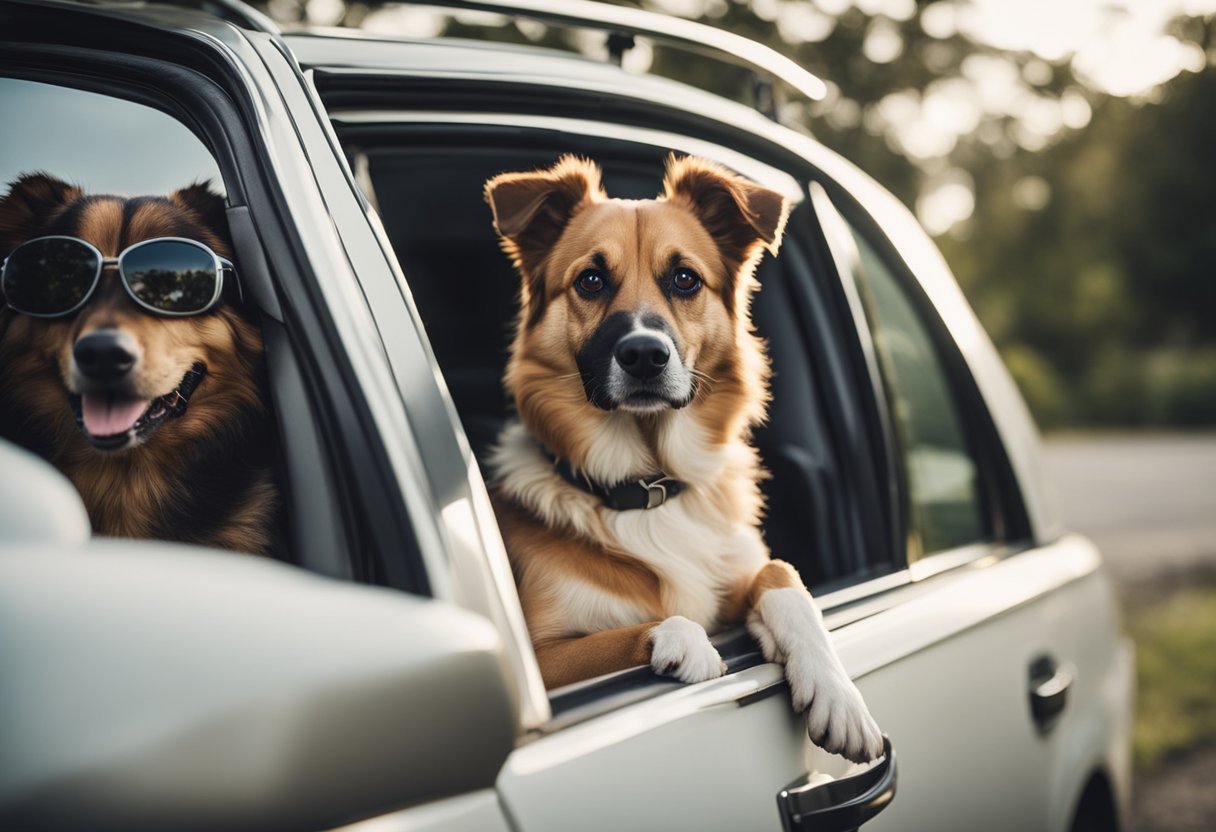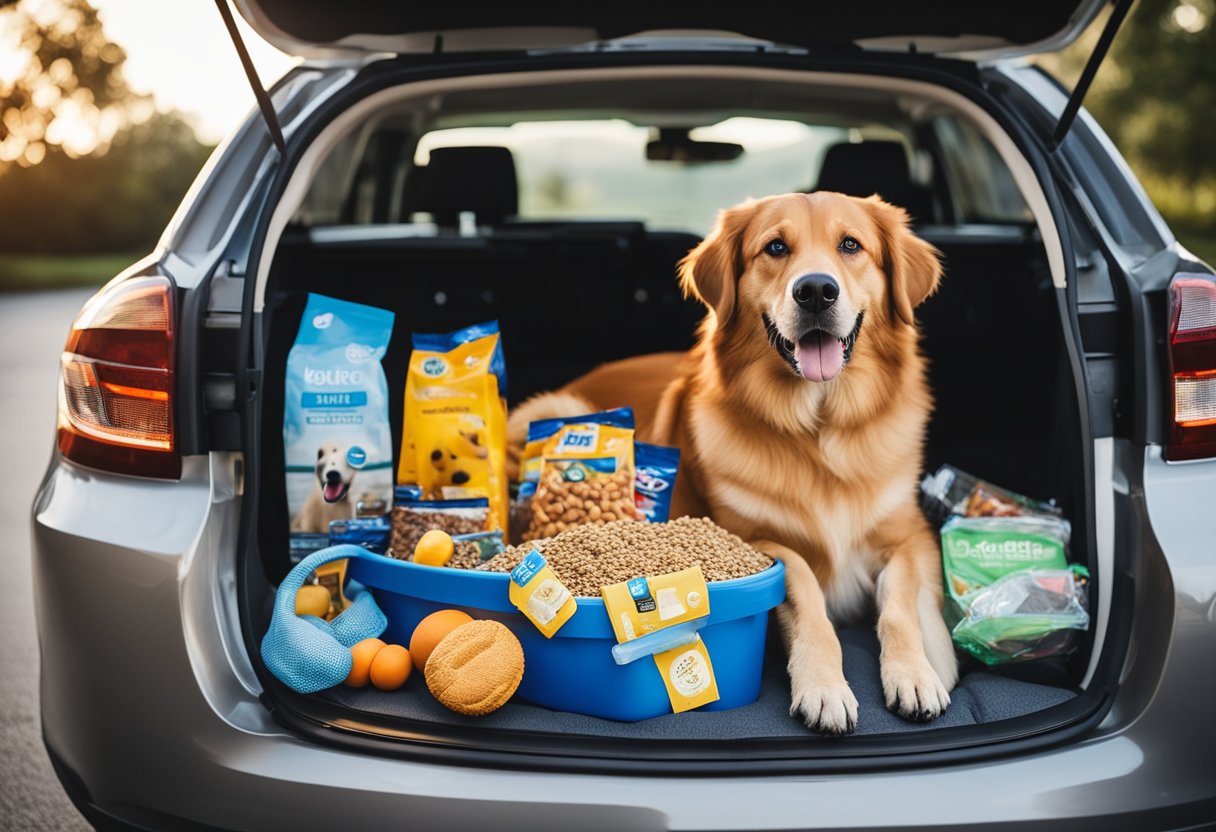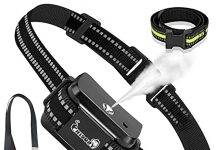Taking a road trip with your furry friend can be an exciting adventure, but it can also be challenging if you’re not well-prepared.
As pet owners, we want to ensure our dogs are comfortable and safe during the journey. Whether you’re planning a short trip or a long one, there are several things you can do to make the journey enjoyable for both you and your dog.
Before hitting the road, it’s essential to prepare for the trip. This includes packing all the necessary items your dog will need, such as food, water, bowls, leash, collar, and identification tags.
It is also crucial to have a comfortable and secure crate or harness for your dog to ride in. Additionally, you should plan your route and make stops to allow your dog to stretch its legs, go potty, and get some fresh air. This article will cover some essential tips for a successful road trip with your dog so you can enjoy the journey.
Preparing for the Journey
Before setting off on a road trip with our dogs, we must ensure we have everything to keep them safe and comfortable. Here are some essential steps to take before hitting the road.
Choosing the Right Crate or Harness
One of our most critical decisions is whether to use a crate or a safety harness for our dog. Both options have pros and cons, so choosing the one that works best for our pet’s size and temperament is essential. If we decide to use a crate, we need to ensure it’s the right size and that our dog is familiar with it before the trip. If we opt for a safety harness, we must ensure it’s properly fitted and secured.
Packing Essentials
We must pack a few essential items to make our dog’s journey comfortable. These include food and water bowls, food and treats, a leash, poop bags, toys, and a blanket or bed. We also need to pack a first aid kit in case of emergencies.
Updating Identification and Medical Records
Before setting off on a road trip, we need to ensure our dog’s identification tags and microchip information are current. We also need to bring our dog’s medical records in emergencies. If our dog requires medication, we must ensure enough for the trip.
Pre-Trip Veterinary Visit
We should schedule a pre-trip veterinary visit to ensure our dog is healthy enough to travel. During this visit, we can also update our dog’s vaccinations and discuss any concerns about the trip. Our veterinarian can also provide us with a dog road trip packing list to ensure we have everything we need for a safe and comfortable journey.
Taking these essential steps before our road trip with our dog can ensure a safe and comfortable journey for everyone involved.
Safety Measures
Safety should be your top priority when traveling with dogs. Here are some tips to keep your furry friend safe and secure.
Securing Your Dog in the Vehicle
Just like humans, dogs need to be secured in the car to prevent injury in case of an accident. The best way to secure your dog is by using a seatbelt or a crate. Special seatbelt harnesses designed for dogs can be attached to the car’s seatbelt. Alternatively, you can use a securely fastened crate in the car. Ensure the crate is large enough for your dog to stand up, turn around, and lie comfortably.
Understanding Dog Anxiety and Motion Sickness
Some dogs may experience anxiety or motion sickness during car rides. To help ease their anxiety, you can try desensitizing them to the car by taking short trips around the block and gradually increasing the distance. You can also try calming music or using a calming spray or collar.
If your dog is prone to motion sickness, avoid feeding them for a few hours before the trip and take frequent breaks to allow them to rest and drink water. You can also talk to your vet about medication to help prevent motion sickness.
Following these safety measures ensures that your dog stays safe and comfortable during your road trip.
On the Road
When we hit the road with our furry friends, we need to be prepared for any situation that may arise. Here are some tips for managing food and hydration, planning potty and exercise breaks, and finding dog-friendly stops.
Managing Food and Hydration
It’s essential to keep our dogs well-fed and hydrated on the road. We should bring plenty of water and a travel bowl for our dog to drink from. We should also feed our dogs at least three to four hours before leaving to avoid any accidents in the car. We can bring our dog’s food on the road to ensure they get the proper nutrition.
Planning for Potty and Exercise Breaks
Our dogs must take potty breaks and stretch their legs during the road trip. We should plan for stops every two to three hours to let our dogs relieve themselves and get some exercise. We can look for rest stops, dog parks, or other pet-friendly areas.
Finding Dog-Friendly Stops
We should look for pet-friendly hotels and national parks that allow dogs when planning our road trip. We can also use online resources to find dog-friendly restaurants and attractions along our route. It’s essential to call ahead and confirm that our furry friends are welcome before we arrive.
By following these tips, we can ensure that our road trip with our dog is a fun and stress-free experience for everyone involved.
Entertainment and Comfort
Keeping them entertained and comfortable is essential when traveling with our furry friends. Here are some tips to help make the journey more enjoyable for everyone.
Bringing Toys and Bedding
Bringing your dog’s favorite toys and bedding can help them feel more at home while on the road. Pack their favorite chew toys, balls, and stuffed animals to keep them entertained during long stretches of driving. Consider bringing a familiar blanket or bed to help them feel more secure and comfortable in new surroundings.
Creating Positive Experiences
Creating positive experiences for your dog while on the road can help reduce stress and anxiety. Take frequent breaks to allow your dog to stretch its legs and explore new surroundings. Consider stopping at dog-friendly parks or beaches to give your dog a chance to run and play. Bring treats and toys to reward good behavior and help create positive associations with the trip.
Overall, keeping your dog entertained and comfortable on the road can help make the journey more enjoyable. Bringing their favorite toys and bedding and creating positive experiences can help reduce stress and anxiety and make the trip a fun and memorable experience for your furry friend.
Dining and Accommodation
Finding pet-friendly dining and accommodation options is crucial when road-tripping with our furry friends. Here are some tips to help make the process easier.
Locating Pet-Friendly Restaurants
Finding restaurants that allow dogs can be challenging, but it’s not impossible. Many restaurants have dog-friendly outdoor seating areas, so be sure to call ahead and check. You can also use websites and apps like BringFido and Yelp to locate pet-friendly restaurants in the area.
When dining with your dog, bring a water bowl and some treats. Keep your dog on a leash and well-behaved. Avoid feeding your dog from the table, which can encourage begging and bad behavior.
Booking Pet-Friendly Hotels
Planning is critical when booking pet-friendly hotels. Many hotels have limited pet-friendly rooms, so be sure to book early. You can use websites and apps like Booking.com and Expedia to locate pet-friendly hotels in the area.
When booking a hotel, be sure to check the pet policy. Some hotels have weight restrictions or breed restrictions, so double-check before booking. You should also bring your dog bed and food bowls, as many hotels do not provide them.
By following these tips, you can ensure your road trip with your furry friend succeeds.
Training and Behavior
When planning a road trip with our furry friends, it’s essential to consider their training and behavior. Here are some tips to ensure a smooth and enjoyable trip for all:
Reinforcing Training and Recall
Before hitting the road, we must reinforce our dogs’ training and recall skills. This includes basic commands such as “sit,” “stay,” and “come.” Practicing these commands regularly in various settings will help our dogs stay focused and obedient during the trip.
Additionally, it’s essential to ensure our dogs are up to date on their vaccinations and have identification tags with current contact information. In case of an emergency or if our dog were to get lost, having proper identification can help ensure a safe return.
Acclimating Your Dog to Car Rides
If our dog is not used to car rides, it’s essential to gradually acclimate them to the experience. Start with short trips around the block and gradually increase the duration and distance of the rides. This will help our dogs become more comfortable and less anxious during longer road trips.
Ensuring our dogs are properly secured in the car is also essential. This can be achieved using a crate, seat belt, or car harness. Not only does this ensure our dogs’ safety, but it also helps prevent distractions while driving.
By reinforcing our dogs’ training and acclimating them to car rides, we can help ensure a safe and enjoyable road trip for all.
Post-Trip Considerations
After a fun-filled road trip with our furry friends, assessing their travel experience and planning for future trips is essential. Here are some critical post-trip considerations that every dog owner should consider.
Assessing Your Dog’s Travel Experience
After a road trip with your dog, the first step is to evaluate their travel experience. Were they happy and comfortable throughout the journey, or were they anxious and stressed? Did they experience any motion sickness or other health issues? Assessing your dog’s travel experience will help you identify any areas that need improvement and make necessary changes before your next trip.
One way to assess your dog’s travel experience is to journal their behavior during the trip. Note any changes in appetite, energy levels, and behavior. Also, please pay attention to how they react to stimuli, such as loud noises, unfamiliar smells, and new environments. This information will help you plan future trips and adjust to ensure your dog’s comfort and safety.
Planning for Future Road Trips
Once you’ve evaluated your dog’s travel experience, it’s time to plan for future road trips. Here are some tips to help you plan for a successful trip with your furry friend:
- Choose pet-friendly accommodations: When planning your road trip, look for pet-friendly hotels, motels, and campgrounds that allow dogs and offer pet-friendly amenities such as dog beds, food bowls, and treats.
- Pack essential items: Make a list of essential items to pack for your dog, including food, water, treats, toys, and medications. Also, bring a first-aid kit and a copy of your dog’s medical records in an emergency.
- Plan for frequent breaks: Just like humans, dogs need frequent breaks during long car rides. Plan for regular stops to allow your dog to stretch their legs, use the bathroom, and get fresh air.
- Secure your dog in the car: To ensure your dog’s safety during the trip, secure them. Use a pet carrier, dog seat belt, or travel crate to keep your furry friend safe and comfortable.
By following these tips and assessing your dog’s travel experience, you can ensure that your next road trip with your furry friend will succeed.
Frequently Asked Questions
What are the essential items for a dog on a road trip?
When packing for a road trip with your furry friend, it is crucial to bring the essentials. These include food, water, bowls, a leash, a collar, waste bags, and a first aid kit. You may also want to bring your dog’s favorite toys, blankets, and beds to make them feel more at home.
How can I ensure my dog stays calm during a long car ride?
Long car rides can be stressful for dogs, but there are ways to help them stay calm. Before the trip, take your dog for a long walk or run to tire them out. Additionally, you may want to consider using calming aids such as pheromone sprays or natural remedies like chamomile or lavender. It is also essential to provide your dog with a comfortable space in the car, whether in a crate or a designated seat with a harness.
What are the best strategies for planning a road trip with a dog?
Planning is vital to a successful road trip with your furry friend. Before you hit the road, research dog-friendly accommodations, restaurants, and attractions along your route. It is also important to schedule regular breaks for your dog to stretch their legs and use the bathroom. Finally, ensure your dog is up to date on their vaccinations and has any necessary medications before you depart.
How often should I stop for my dog’s breaks during a road trip?
It is recommended that you stop every 2-3 hours for your dog’s breaks during a road trip. During these breaks, make sure to offer your dog water, a chance to stretch its legs, and a chance to use the bathroom. Additionally, it is essential to never leave your dog alone in the car, especially on hot days.
Are there any special considerations for taking a dog on a long car journey?
If you are planning a very long car journey with your dog, there are a few additional considerations to keep in mind. Pack enough food and water for the entire trip, and consider bringing a portable water bowl for easy access. Additionally, you may want to consider a dog ramp or stairs to help your dog get in and out of the car more easily.
How can I tell if my dog is stressed during a road trip, and what should I do?
Dogs can exhibit various signs when they feel stressed during a road trip, including panting, drooling, whining, or restlessness. If you notice these signs, taking a break and giving your dog some calming reassurance is essential. Additionally, you may want to consider using calming aids or natural remedies to help your dog relax. If your dog’s stress persists, it is essential to consult with your veterinarian.
Need to escape from the city but don’t want to leave your dog behind?
Road trips with dogs can be fun as long as you prepare well. Moreover, they are a big way to spend quality time with your best friend.
Road Trip with Your Dog: The Ultimate Guide
Here’s how to set up your dog for road trips:
So, how can you ensure that you and your dog stay safe and happy during long road trips?
We rounded up experts’ top tips for road trips with your dog. Don’t hit the road without reading these points!
Plan a pet-friendly route.
When you are on a road trip with your dog, you must plan around their requirements—pulling over for potty breaks and exercise.
Ensure your route has excellent, safe places to let your pet stretch their legs.
Most major rest stops have dog areas where dogs can go to the bathroom, stretch their legs, and play.
You should take COVID-19 precautions into account while you’re planning to. Your route should avoid crowded places or where you’d be unable to maintain 6 feet of distance between yourself and another person.
Your dog should stay 6 feet apart from other humans, too. A general rule is to treat pets like family members.
Use Positive Reinforcement & Reward Your Dog with Treats
A compliant dog will be easier to road trip with than a dog constantly misbehaving. We’ve been training Charlie using the positive reinforcement technique.
That means we reward him with a Wellness Core 100% Freeze-Dried all-meat dog treat when Charlie does what he is told. These treats are 100% raw protein and completely grain and filler-free.
Charlie is a picky eater….but he especially loves the Wellness wild boar and turkey bites, giving him a tasty and healthy incentive to be on his best behavior.
For example, when he first jumps into the van, he gets a treat, which shows him that getting in the truck without being coerced is what he’s supposed to do.
Then, if we stop at a gas station and he goes to the bathroom, he gets a treat. Then, when we call him back into the car and jump in, he gets another pleasure.
On the road, if we eat lunch in the car and sit silently in the back without begging, he gets a treat.
Over time, they learn to perform the desired behavior, whether rewarded or not. Positive reinforcement with treats is a great tool when starting a road trip with your dog.
Another thing about the Wellness Core, 100% Freeze, Dried dog treats is that they are bite-sized, so even if you reward your dog regularly, the bag should last a while on your road trip.
Take practice trips ahead of time.
Consider trying behavioral training methods if your dog is predominantly anxious during car rides.
Before leaving on a long road trip with your dog, take some short practice trips that end in joyful experiences for them.
For instance, rides to the dog park or a favorite pet store will help form more positive alliances with driving.
Pack the essentials
Traveling with your pet’s necessities is always an excellent thought, particularly now.
Packing your pet’s food and water treats, medicine, toys, feeding bowls, and other supplies will assist in keeping you out of stores and veterinary offices, which can be crowded places that put you at augmented risk of contracting the virus.
Remember to bring equipment to pick up pet waste so that everything can be disposed of securely.
Read Next – Petsafe Easy Walk Harness
Have a Copy of His Medical Records on Hand
You should bring a copy of your pup’s medical records in case of an emergency.
It’s a good idea to store them on your phone and have hard copies because you could end up in an area with bad cell phone service.
Find Pet-Friendly Accommodations
Several hotel chains provide pet-friendly accommodations for you and your canine best friend.
They include Aloft Hotels, Best Western, Comfort Inn, Clarion Inn & Suites, Courtyard Marriott, Holiday Inn Express, Red Roof Inn, and Sheraton.
Read Next – Best Dog Accessories












































